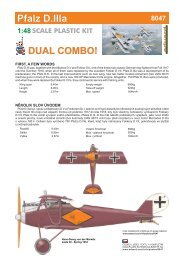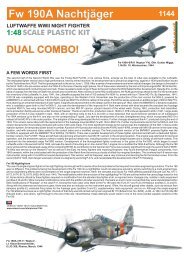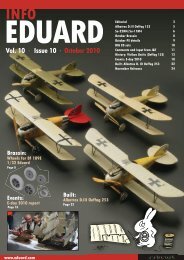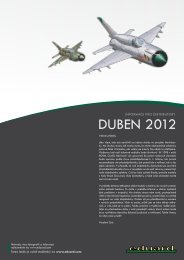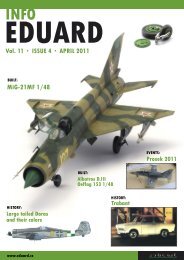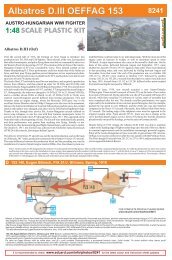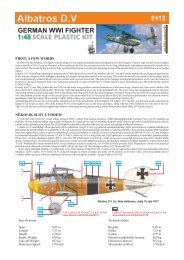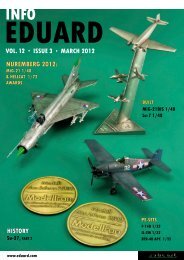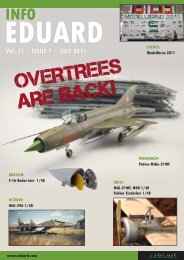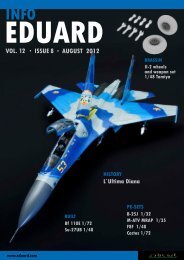E Albatros D.III (Oef) 253.116 Sgt., Adolf Blaha, November ... - Eduard
E Albatros D.III (Oef) 253.116 Sgt., Adolf Blaha, November ... - Eduard
E Albatros D.III (Oef) 253.116 Sgt., Adolf Blaha, November ... - Eduard
Create successful ePaper yourself
Turn your PDF publications into a flip-book with our unique Google optimized e-Paper software.
<strong>Albatros</strong> D.<strong>III</strong> OEFFAG 253<br />
AUSTRO-HUNGARIAN WWI FIGHTER<br />
1:48 SCALE PLASTIC KIT<br />
<strong>Albatros</strong> D.<strong>III</strong> (<strong>Oef</strong>)<br />
Over the second half of 1916, the German air force began to introduce into<br />
production new D.I, D.II and D.<strong>III</strong> fighters. These aircraft, at the very, least equaled<br />
their allied counterparts, and pilots flying them were able to command the skies over<br />
the Western Front into the spring of 1917. The situation of the air force of the Austro-<br />
Hungarian Empire (LFT) was considerably worse. They entered combat on the<br />
Hansa-Brandenburg D.I. Their performance could not match that of the Italian air<br />
force, and their poor flying qualities proved dangerous to less experienced pilots.<br />
Despite this, their presence was invaluable to the LFT, and its pilots were able to rack<br />
up a score of some 78 enemy aircraft.<br />
The head of the LFT realized the need for new machines, and acquired a production<br />
license from <strong>Albatros</strong>, and then placed an order for 20 D.IIs and 30 D.<strong>III</strong>s with<br />
Oesterreichische Flugzeugfabrik AG (<strong>Oef</strong>fag) in December, 1916. The aircraft were<br />
to be delivered in the first quarter of 1917, and the LFT designated the aircraft type as<br />
1<br />
53 . Subsequently, the order was changed to 16 D.IIs (53.01 to 53.16) and 34 D.<strong>III</strong>s,<br />
and to a further eleven D.<strong>III</strong>s in March. In all, 45 D.<strong>III</strong>s (53.20 to 53.64) were<br />
ordered. Austro-Hungarian aircraft differed from German production. First and<br />
foremost came an engine change, where the Mercedes D.<strong>III</strong> gave way to the<br />
excellent Austro-Daimler rated at 180hp. Changes were also seen in the armament,<br />
that saw the internal installation of Austrian Schwarzlose machine guns, the cockpit<br />
interior and radiator were changed, and, above all, the D.<strong>III</strong> had strengthened wings.<br />
Thanks to this, through their service life, Austro-Hungarian aircraft suffered no<br />
lower wing collapses, as was the case with their German counterparts. Series 53<br />
aircraft were delivered to the LFT through May to July, 1917. They appeared on the<br />
front after trials at the beginning of June. The aircraft were enthusiastically greeted,<br />
and their performance was greater than anything else flying, friendly or not.<br />
Furthermore, they demonstrated good flight characteristics, and were easy to contol.<br />
On October 6, 1917, the first kill was achieved with Feldwebel Julius Kowalczyk<br />
of Flik 24 at the controls, downing an Italian Caproni.<br />
The delivery of 64 Series 53 aircraft was not the end of production, and on the basis<br />
of a February, 1917 order, production continued with a further 61 Series 153 aircraft.<br />
The main difference between this production block and the preceding one was the<br />
installation of a Austro-Daimler engine rated at 200hp. Also, the exhaust system was<br />
E <strong>Albatros</strong> D.<strong>III</strong> (<strong>Oef</strong>) <strong>253.116</strong> <strong>Sgt</strong>., <strong>Adolf</strong> <strong>Blaha</strong>, <strong>November</strong> 1919<br />
H53<br />
13<br />
26<br />
14 27<br />
H301<br />
301<br />
H85<br />
45<br />
39<br />
13<br />
FOR COMPLETE PROFILE PLEASE REFER<br />
www.eduard.com/info/photos/8242<br />
H303<br />
303<br />
8242<br />
On <strong>November</strong> 21, 1918, Zgsf. <strong>Adolf</strong> <strong>Blaha</strong> in <strong>Albatros</strong> <strong>253.116</strong>, together with Stfw. Bela Mayer in <strong>Albatros</strong> 253.114 of Flik 3/J flew to Switzerland. Here, the aircraft<br />
remained interned, and the pilots released in the spring of 1919. Czechoslovakia was interested in acquiring the aircraft, and after almost a year of negotiating, was<br />
successful. However, 253.114 remained in Switzerland as compensation for the storage of both aircraft. On October 29, 1919, <strong>Blaha</strong> flew <strong>253.116</strong> to Plzeò, from<br />
where he continued on to Kbely in Prague on <strong>November</strong> 1st. Here, however, the aircraft was written off in a forced landing after engine failure, which was later<br />
installed into the only Czechoslovak Fokker D.VII(MAG) (<strong>Eduard</strong> Kit 1147).<br />
The aircraft appearance changed minimally, the removal of armament and the overpainting of the crosses on the tail and top wing. The bottom wing acquired<br />
Czechoslovak markings, likely with a thin red border.<br />
eduard<br />
modified from a collector pipe to six individual stacks. With the more powerful<br />
engine came an increase in weight, as well as maximum speed to some<br />
190 km/h. A major improvement also came in the aircraft’s climb rate. On the<br />
heels of this series, delivered between August and September, 1917, came<br />
another run, aircraft 153.62 to 153.111 against a June order. These were identical<br />
to that preceding order, and were delivered by <strong>Oef</strong>fag between August and<br />
<strong>November</strong>. Even that wasn’t the end of the production run, as a further 100<br />
(153.112 to 153.211) were ordered in October, 1917, followed by another<br />
seventy (153.212 to 153.281). Aircraft from the final two orders were delivered<br />
by June, 1918. Aircraft from 153.112 to 153.281 differed with a more rounded<br />
front end, boosting the top speed to 198km/h.<br />
Starting in June, 1918, new aircraft acquired a new Austro-Daimler<br />
225hp engine. These aircraft were part of Series 253, on the basis of two orders<br />
for a total of 330 aircraft. By the end of the war, the LFT accepted 186 Series 253<br />
aircraft, while there remained 74 airframes in various states of assembly that<br />
were completed after the war. The already excellent performance was again<br />
improved by the installation of an even more powerful engine, that, for example,<br />
pushed the top speed to over 200km/h, and the climb rate was also bettered<br />
compared to the Series 153 aircraft. Physically, they differed little from Series<br />
153 aircraft. The trailing edge of the tailplanes were wired as opposed to the<br />
original wooden strips. From aircraft 253.31, there was also a change in the<br />
cowl, that had deeper engine cut-out. Series 253 planes also had the armament<br />
placed mostly on top of the fuselage, as was the case on German aircraft.<br />
Despite being of 1916 vintage, the <strong>Albatros</strong> D.<strong>III</strong> (<strong>Oef</strong>) was able to maintain<br />
a spot on the leading edge of fighter technology up to the end of the war, thanks<br />
to constant improvements and the installation increasingly powerful engines.<br />
Pilots of the Austro-Hungarian air force were able to gain at least 320 victories.<br />
<strong>Oef</strong>fags were used in combat even after the war, namely with the Polish air force.<br />
The Poles bought 38 aircraft from 253.212 to 257 in 1919, and pressed them into<br />
service against Bolshevik Russia.<br />
Note 1: In the system of LFT designation, the numeral 5 was allocated to the <strong>Oef</strong>fag factory. This was followed by a sequential production type. If, within the production run, there was a major<br />
modification to the type, such as the installation of a new engine, there appeared a prefix number (with the second variant it was a '1', with the third, it was a '2', and so on). The series number of<br />
each aircraft was composed of the type number, which was followed by a period, and the sequential unit number of the aircraft within the line of a production block. For example, <strong>Albatros</strong><br />
D.<strong>III</strong> (<strong>Oef</strong>) <strong>253.116</strong> designates the 116th aircraft of the third variant of the third type manufactured by <strong>Oef</strong>fag.<br />
ÈESKOU VERZI TEXTU A KOMPLETNÍ<br />
KAMUFLÁŽNÍ SCHÉMA NALEZNETE NA<br />
www.eduard.com/info/photos/8242<br />
It is recommended to check www.eduard.com/info/photos/8242 for the latest colour and instruction sheet updates.
2<br />
ATTENTION UPOZORNÌNÍ<br />
ACHTUNG ATTENTION<br />
GB<br />
CZ<br />
F<br />
D<br />
JP<br />
INSTRUCTION SIGNS<br />
OPTIONAL<br />
VOLBA<br />
FACULTATIF<br />
NACH BELIEBEN<br />
Carefully read instruction sheet before assembling. When you use glue or paint, do not use near open flame and use in well ventilated room. Keep out of<br />
reach of small children. Children must not be allowed to suck any part, or pull vinyl bag over the head.<br />
Pøed zapoèetím stavby si peèlivì prostudujte stavební návod. Pøi používání barev a lepidel pracujte v dobøe vìtrané místnosti. Lepidla ani barvy<br />
nepoužívejte v blízkosti otevøeného ohnì. Model není urèen malým dìtem, mohlo by dojít k požití drobných dílù.<br />
Iire soigneusement la fiche d´instructions avant d´assembler. Ne pas utiliser de colle ou de peinture `a<br />
p roximité d´une flamme nue, et aérer la piece de<br />
temps en temps. Garder hors de portée des enfants en bas âge. Ne pas laisser les enfants mettre en bouche ou sucer les pièces, o u p asser u n s achet v inyl s ur<br />
la t ete.<br />
Von dem Zusammensetzen die Bauanleitung gut durchlesen. Kleber und Farbe nicht nahe von offenem Feuer verwenden und das Fenster von Zeit zu Zeit<br />
Belüftung öffnen. Bausatz von kleinen Kindern fernhalten. Verhüten Sie, daß Kinder irgendwelche Bauteile in den Mund nehmen oder Plastiktüten über<br />
den Kopf ziehen.<br />
BEND<br />
OHNOUT<br />
PLIER SIL VOUS PLAIT<br />
BITTE BIEGEN<br />
INSTR. SYMBOLY INSTRUKTION SINNBILDEN SYMBOLES<br />
OPEN HOLE<br />
VYVRTAT OTVOR<br />
FAIRE UN TROU<br />
OFFNEN<br />
SYMETRICAL ASSEMBLY<br />
SYMETRICKÁ MONTÁŽ<br />
MONTAGE SYMÉTRIQUE<br />
SYMMETRISCHE AUFBAU<br />
NOTCH<br />
ZÁØEZ<br />
L INCISION<br />
DER EINSCHNITT<br />
REMOVE<br />
ODØÍZNOUT<br />
RETIRER<br />
ENTFERNEN<br />
PARTS DÍLY<br />
TEILE PIECES<br />
PLASTIC PARTS<br />
A> B> C><br />
1<br />
9<br />
14<br />
4<br />
D> X><br />
7<br />
3<br />
5<br />
2 3<br />
5<br />
10<br />
15<br />
2<br />
6<br />
6<br />
11<br />
16<br />
1<br />
8<br />
7 8<br />
12<br />
17<br />
19 20 21 21<br />
23<br />
4<br />
eduard<br />
COLOURS BARVY<br />
FARBEN PEINTURE<br />
GSi Creos (GUNZE)<br />
AQUEOUS<br />
26<br />
22<br />
24 25<br />
Mr.COLOR<br />
H 11 C62 FLAT WHITE<br />
H 12 C33 FLAT BLACK<br />
H 13<br />
C3<br />
13<br />
FLAT RED<br />
H 37 C43 WOOD BROWN<br />
H 47<br />
H 53<br />
H 70<br />
C41<br />
C13<br />
C60<br />
RED BROWN<br />
18<br />
NEUTRAL GRAY<br />
RLM02 GRAY<br />
H 72 C22 DARK EARTH<br />
4<br />
25<br />
9<br />
9<br />
15<br />
22<br />
1<br />
5<br />
1<br />
2<br />
3<br />
6<br />
10 11 12 13 14<br />
16<br />
26<br />
17<br />
5<br />
6<br />
7<br />
10 10<br />
11 11<br />
2<br />
7<br />
18 19 20<br />
23<br />
27<br />
24<br />
AQUEOUS<br />
H 73<br />
H 344<br />
13<br />
8<br />
3<br />
21<br />
12<br />
28<br />
28<br />
8<br />
Mr.COLOR<br />
C23<br />
DARK GREEN<br />
H 85 C45 SAIL COLOR<br />
H 301 C301 GRAY<br />
H 303 C303 GREEN<br />
Mr.METAL COLOR<br />
RUST<br />
MC214 DARK IRON<br />
MC218 ALUMINIUM<br />
MC219 BRASS<br />
2<br />
APPLY EDUARD MASK<br />
AND PAINT<br />
POUŽÍT EDUARD MASK<br />
NABARVIT<br />
4 5<br />
6<br />
8<br />
PE - PHOTO ETCHED<br />
DETAIL PARTS<br />
1<br />
10<br />
9<br />
7<br />
3
X8<br />
MC218<br />
ALUMINIUM<br />
PE24<br />
X10<br />
MC218<br />
ALUMINIUM<br />
X2 X10<br />
H 301<br />
C301<br />
GRAY<br />
H 301<br />
C301<br />
GRAY<br />
C1<br />
MC218<br />
ALUMINIUM<br />
H 37<br />
C43<br />
WOOD BROWN<br />
B7<br />
H 12<br />
C33<br />
FLAT BLACK<br />
MC218<br />
ALUMINIUM<br />
H 37<br />
C43<br />
WOOD BROWN<br />
A17<br />
PE28<br />
H 301<br />
C301<br />
GRAY<br />
MC214<br />
DARK IRON<br />
A2<br />
X11<br />
MC214<br />
DARK IRON<br />
B10<br />
MC218<br />
ALUMINIUM<br />
PE27<br />
A13<br />
MC218<br />
ALUMINIUM<br />
H 301<br />
C301<br />
GRAY<br />
H 47<br />
C41<br />
RED BROWN<br />
X9<br />
PE3<br />
PE27<br />
X1<br />
MC218<br />
ALUMINIUM<br />
X11<br />
H 37<br />
decal C43<br />
WOOD BROWN<br />
47<br />
PE7<br />
B13<br />
MC214<br />
DARK IRON<br />
H 12<br />
C33<br />
FLAT BLACK<br />
PE9<br />
PE13<br />
decal<br />
54<br />
decal 51<br />
MC218<br />
ALUMINIUM<br />
PE4<br />
MARKING B ; C ; D ; E<br />
C1<br />
A2<br />
H 37<br />
C43<br />
WOOD BROWN<br />
PE5<br />
PE17<br />
PE16<br />
H 12<br />
C33<br />
FLAT BLACK<br />
H 301<br />
C301<br />
GRAY<br />
A5<br />
A1<br />
B17<br />
MC218<br />
ALUMINIUM<br />
A5<br />
H 301<br />
C301<br />
GRAY<br />
A17<br />
A18<br />
B7<br />
B2<br />
X6<br />
MC218<br />
ALUMINIUM<br />
H 37<br />
C43<br />
WOOD BROWN<br />
X5<br />
H 12<br />
C33<br />
FLAT BLACK<br />
MC218<br />
ALUMINIUM<br />
X12<br />
X3<br />
X3<br />
X5 X13<br />
A14<br />
B11<br />
A13<br />
H 37<br />
C43<br />
WOOD BROWN<br />
H 47<br />
C41<br />
RED BROWN<br />
decal 49<br />
PE11<br />
A4<br />
A20<br />
H 37<br />
C43<br />
WOOD BROWN<br />
H 37<br />
C43<br />
WOOD BROWN<br />
A19<br />
A23<br />
H 301<br />
C301<br />
GRAY<br />
A9<br />
H 37<br />
C43<br />
WOOD BROWN<br />
C10<br />
C10<br />
X7<br />
PE1<br />
X13<br />
H 12<br />
C33<br />
FLAT BLACK<br />
H 301<br />
C301<br />
GRAY<br />
A16<br />
H 37<br />
C43<br />
WOOD BROWN<br />
PE2<br />
H 12<br />
C33<br />
FLAT BLACK<br />
PE1<br />
MC214<br />
DARK IRON<br />
PE15<br />
PE14 decal 53<br />
decal 52<br />
PE8<br />
A23<br />
A16<br />
MC218<br />
ALUMINIUM<br />
A10<br />
3
4<br />
C1<br />
MARKING<br />
PE27<br />
A13<br />
H 301<br />
C301<br />
GRAY<br />
H 37<br />
C43<br />
WOOD BROWN<br />
A<br />
H 47<br />
C41<br />
RED BROWN<br />
PE27<br />
MC214<br />
DARK IRON<br />
B10<br />
PE10<br />
A22, B24 - MARKING B ; C ; D ONLY<br />
MARKING B ; C ; D ; E<br />
B21<br />
B9<br />
H 301<br />
C301<br />
GRAY<br />
H 37<br />
C43<br />
WOOD BROWN<br />
decal 48<br />
PE13<br />
C1<br />
decal 51<br />
H 37<br />
C43<br />
WOOD BROWN<br />
B27<br />
MC214<br />
DARK IRON<br />
A25<br />
D2<br />
B18<br />
H 12<br />
C33<br />
FLAT BLACK<br />
B18<br />
H 301<br />
C301<br />
GRAY<br />
A22<br />
A1<br />
MC214<br />
DARK IRON<br />
MC218<br />
ALUMINIUM<br />
H 301<br />
C301<br />
GRAY<br />
H 301<br />
C301<br />
GRAY<br />
H 301<br />
C301<br />
GRAY<br />
H 37<br />
C43<br />
WOOD BROWN<br />
B7<br />
A17<br />
A18<br />
B7<br />
A17<br />
MC214<br />
DARK IRON<br />
PE28<br />
B11<br />
H 301<br />
C301<br />
GRAY<br />
A13<br />
A2<br />
B24<br />
A14<br />
H 37<br />
C43<br />
WOOD BROWN<br />
MC218<br />
ALUMINIUM<br />
H 47<br />
C41<br />
RED BROWN<br />
decal 49<br />
PE11<br />
A4<br />
H 47<br />
C41<br />
RED BROWN<br />
MC218<br />
ALUMINIUM<br />
B12<br />
A20<br />
H 37<br />
C43<br />
WOOD BROWN<br />
H 37<br />
C43<br />
WOOD BROWN<br />
A19<br />
A23<br />
MARKING<br />
B ; C ; D<br />
ONLY<br />
H 301<br />
C301<br />
GRAY<br />
A9<br />
H 37<br />
C43<br />
WOOD BROWN<br />
C10<br />
C10<br />
PE1<br />
MARKING E ONLY<br />
H 301<br />
C301<br />
GRAY<br />
A16<br />
H 37<br />
C43<br />
WOOD BROWN<br />
PE2<br />
A23<br />
H 12<br />
C33<br />
FLAT BLACK<br />
PE1<br />
MC214<br />
DARK IRON<br />
PE15<br />
PE14 decal 53<br />
decal 52<br />
PE8<br />
A16<br />
MC218<br />
ALUMINIUM<br />
A10
MARKING<br />
B28<br />
MC214<br />
DARK IRON<br />
MC218<br />
ALUMINIUM<br />
B23 H 344<br />
RUST<br />
PE20<br />
A<br />
B19<br />
H 12<br />
C33<br />
FLAT BLACK<br />
MC214<br />
DARK IRON<br />
C3<br />
MARKING B ; C ; D<br />
D8<br />
MC214<br />
DARK IRON<br />
C2<br />
B28<br />
PE12<br />
B21<br />
H 12<br />
C33<br />
FLAT BLACK<br />
B16<br />
H 37<br />
C43<br />
WOOD BROWN<br />
PE20<br />
MARKING B ONLY<br />
B28<br />
C8<br />
D7<br />
B28<br />
C3<br />
MC214<br />
DARK IRON<br />
B24<br />
A22<br />
B20<br />
MC218<br />
ALUMINIUM<br />
H 47<br />
C41<br />
RED BROWN<br />
MC218<br />
ALUMINIUM<br />
B12<br />
PE26<br />
D1<br />
C9<br />
5
6<br />
D4<br />
A8<br />
PE25<br />
A21<br />
A7<br />
A6, B6<br />
H 301<br />
C301<br />
GRAY<br />
A21<br />
PE18<br />
B6<br />
MC219<br />
BRASS<br />
PE25<br />
H 301<br />
C301<br />
GRAY<br />
A24<br />
H 37<br />
C43<br />
WOOD BROWN<br />
MARKING D , E ONLY<br />
A11<br />
H 301<br />
C301<br />
GRAY<br />
A15<br />
A12<br />
MC219<br />
BRASS<br />
H 301<br />
C301<br />
GRAY<br />
A21<br />
A6<br />
B5<br />
PE25<br />
C5<br />
DECAL 45<br />
B4+<br />
A26<br />
D4<br />
D4<br />
LONGER AHEAD<br />
A8,<br />
B4<br />
FWD<br />
DECAL 23+ 24<br />
PE6<br />
H 53<br />
C13<br />
NEUTRAL GRAY<br />
H 301<br />
C301<br />
GRAY<br />
A26<br />
C7<br />
MC219<br />
BRASS<br />
B4<br />
D4<br />
H 12<br />
C33<br />
FLAT BLACK<br />
B15<br />
H 37<br />
C43<br />
WOOD BROWN
PE22<br />
PE21<br />
C301<br />
H 301<br />
GRAY<br />
A3<br />
PE19<br />
PE23<br />
H 301<br />
C301<br />
GRAY<br />
H 301<br />
C301<br />
GRAY<br />
PE19+ PE23<br />
PE19+ PE23<br />
7
A<br />
56<br />
H37<br />
43<br />
Mc218<br />
56<br />
21<br />
H85<br />
45<br />
253.24, Oblt.i.dRes. Benno Fiala, Flik 51/J, Ghirano, September 1918<br />
Aircraft 253.24 typifies the camouflage scheme used on <strong>Albatros</strong> D.<strong>III</strong> (<strong>Oef</strong>) when they left the plant. Wooden and fabric surfaces were covered with<br />
a clear coat, and the metal panels on the fuselage were ‘machined’. The interwing struts and landing gear legs were painted with a dark colour, likely<br />
a dark grey. This aircraft was delivered in June, 1918, and was attached to Flik 51/J, where it was flown in combat by Zgsf. Eugen Bonsch (16 kills),<br />
Korp. Josef Pfisterer, and above all, the CO of Flik 51/J Oblt.i.d.Res. Benno Fiala Ritter von Fernbrugg, who, with 28 kills, became the third most<br />
successful LFT pilot.<br />
8<br />
19<br />
3<br />
ALUMINIUM<br />
Mc218<br />
DOPPED LINEN H85<br />
SAIL COLOUR 45<br />
WOOD<br />
Mc218 2 27<br />
44 H37<br />
43<br />
H53<br />
13<br />
H85<br />
45<br />
H37<br />
43<br />
21<br />
H85<br />
45<br />
GREY<br />
H53<br />
13<br />
H301<br />
301<br />
Mc218<br />
H37<br />
43<br />
DARK GREY H301<br />
301<br />
H37<br />
43<br />
20<br />
1<br />
H37<br />
43<br />
H85<br />
45<br />
1 44 27<br />
Mc218<br />
ÈESKOU VERZI TEXTU NALEZNETE NA<br />
www.eduard.com/info/photos/8242<br />
20<br />
Mc218<br />
H85<br />
45<br />
19<br />
3<br />
eduard
B<br />
56<br />
H37<br />
43<br />
Mc218<br />
56<br />
H85<br />
45<br />
38a+38b<br />
253.32, Flik 63/J, Portobuffolee, September 1918 (Rudolf Nìmec)<br />
On July 31, 1918, an order was issued changing the national insignia on Austro-Hungarian aircraft. The original iron cross was replaced by crosses with<br />
a different design in new positions. Because there was no actual time limit imposed, the changeover was gradual.<br />
The pictured aircraft of Flik 63/J, flown by, among others, Zgsf. Rudolf Nìmec, serves as an example of various interpretations. The rudder cross was<br />
instead located on the fin, and neither was the fuselage marking up to the prescribed standard. The red colouring on the rear section,<br />
the black and white stripes on the fuselage, and the black and white sunbursts on both sides of the wheel discs were Flik 63/J unit markings. The series<br />
number on the sides of the fuselage was scratched out.<br />
ALUMINIUM<br />
DOPPED LINEN H85<br />
SAIL COLOUR 45<br />
WHITE<br />
Mc218<br />
H11<br />
62<br />
WOOD<br />
GREY<br />
Mc218 6 27<br />
33 H37<br />
43<br />
H53<br />
13<br />
H11<br />
62<br />
46<br />
H37<br />
43<br />
H53<br />
13<br />
38c+38d<br />
H85<br />
45<br />
32<br />
DARK GREY H301<br />
301<br />
H12<br />
33<br />
H301<br />
301<br />
RED<br />
H11<br />
62<br />
35<br />
H37<br />
43<br />
H301<br />
301<br />
5+37<br />
H12<br />
33<br />
H11<br />
62<br />
H13<br />
3<br />
H37<br />
43<br />
H85<br />
45<br />
5+37 33 27<br />
H13<br />
3<br />
BLACK<br />
H12<br />
33<br />
H11<br />
62<br />
ÈESKOU VERZI TEXTU NALEZNETE NA<br />
www.eduard.com/info/photos/8242<br />
31<br />
H301<br />
301<br />
H13<br />
3<br />
34<br />
Mc218<br />
46<br />
eduard<br />
9
C<br />
56<br />
H37<br />
43<br />
Mc218<br />
56<br />
21<br />
H85<br />
45<br />
253.36, Oblt. Othmar Wolfan, Flik 56/J, August 1918<br />
The personal aircraft of Othmar Wolfan displays another non-standard representation of the national insignia on Austro-Hungarian aircraft in the<br />
summer of 1918. While the upper surface crosses remained original, the crosses on the rudder were in different proportions than the aircraft before.<br />
The crosses under the wings were non-standard in their size and location. They were actually the same size and location as the original iron crosses.<br />
Othmar Wolfan gained his first and only kill flying this aircraft when, on August 1st, 1918, he downed a Sopwith Camel from 66 Sqd. RAF. On the 14th of<br />
September, 1918, he was severely injured in a crash, and sat out the rest of the war in a hospital bed. Othmar Wolfan was one of a few German pilots<br />
who, after the dissolution of the Austro-Hungarian Empire, served in the Czechoslovak Air Force. He entered service in July, 1919 as an Air Force<br />
Officer. He served, for the most part, with No. 9 Air Company and flew SPADs. He left the Czechoslovak army on January 31, 1921.<br />
10<br />
36<br />
11<br />
DOPPED LINEN H85<br />
SAIL COLOUR<br />
45<br />
WOOD<br />
H53<br />
13<br />
H53<br />
13<br />
H85<br />
45<br />
10<br />
H37<br />
43<br />
21<br />
H85<br />
45<br />
GREY<br />
H53<br />
13<br />
H301<br />
301<br />
Mc218<br />
H37<br />
43<br />
DARK GREY H301<br />
301<br />
42<br />
H37<br />
43<br />
H37<br />
43<br />
22<br />
9 42 ? 41<br />
9<br />
Mc218<br />
ÈESKOU VERZI TEXTU NALEZNETE NA<br />
www.eduard.com/info/photos/8242<br />
H37<br />
43<br />
H85<br />
45<br />
22<br />
H53<br />
13<br />
H85<br />
45<br />
36<br />
11<br />
eduard
D<br />
56<br />
H37<br />
43<br />
Mc218<br />
56<br />
21<br />
H85<br />
45<br />
<strong>253.116</strong>, Oblt. Friedrich Navratil, Flik 3/J, Fall 1918<br />
<strong>Albatros</strong> <strong>253.116</strong> served as the second personal mount of Flik 3/J CO Oblt. Friedrich Navratil. Both aircraft carried virtually the same personal markings,<br />
and 253.06 is easily recognizable by virtue of its internal gun installation.<br />
<strong>253.116</strong> represents typical Flik 3/J colouring, which included the ‘natural’ elements of the fuselage, upper sides of both wings and empanage being<br />
painted over in green and possibly also brown splotches. National insignia in October 1918 remained in their original iron cross guise. Note the use of<br />
the left wheel off of an Aviatik D.1 238.18.<br />
ALUMINIUM<br />
WOOD<br />
19<br />
H53<br />
13<br />
26<br />
14<br />
DOPPED LINEN H85<br />
Mc218 SAIL COLOUR 45<br />
H37<br />
43<br />
GREY<br />
H53<br />
13<br />
21<br />
27<br />
DARK GREY H301<br />
301<br />
H301<br />
301<br />
H85<br />
45<br />
DARK GREEN H73<br />
23<br />
39<br />
20<br />
13<br />
H37<br />
43<br />
H85<br />
45<br />
13 40 27<br />
BROWN<br />
H72<br />
22<br />
Mc218<br />
ÈESKOU VERZI TEXTU NALEZNETE NA<br />
www.eduard.com/info/photos/8242<br />
20<br />
19<br />
eduard<br />
11
E<br />
56<br />
H37<br />
43<br />
Mc218<br />
56<br />
H303<br />
303<br />
H85<br />
45<br />
ALUMINIUM<br />
WOOD<br />
<strong>Albatros</strong> D.<strong>III</strong> (<strong>Oef</strong>) <strong>253.116</strong> <strong>Sgt</strong>., <strong>Adolf</strong> <strong>Blaha</strong>, <strong>November</strong> 1919<br />
On <strong>November</strong> 21, 1918, Zgsf. <strong>Adolf</strong> <strong>Blaha</strong> in <strong>Albatros</strong> <strong>253.116</strong>, together with Stfw. Bela Mayer in <strong>Albatros</strong> 253.114 of Flik 3/J flew to Switzerland. Here, the aircraft<br />
remained interned, and the pilots released in the spring of 1919. Czechoslovakia was interested in acquiring the aircraft, and after almost a year of negotiating, was<br />
successful. However, 253.114 remained in Switzerland as compensation for the storage of both aircraft. On October 29, 1919, <strong>Blaha</strong> flew <strong>253.116</strong> to Plzeò, from<br />
where he continued on to Kbely in Prague on <strong>November</strong> 1st. Here, however, the aircraft was written off in a forced landing after engine failure, which was later<br />
installed into the only Czechoslovak Fokker D.VII(MAG) (<strong>Eduard</strong> Kit 1147).<br />
The aircraft appearance changed minimally, the removal of armament and the overpainting of the crosses on the tail and top wing. The bottom wing acquired<br />
Czechoslovak markings, likely with a thin red border.<br />
H303<br />
303<br />
H53<br />
13<br />
26<br />
14<br />
H303<br />
303<br />
DOPPED LINEN H85<br />
Mc218 SAIL COLOUR 45<br />
H37<br />
43<br />
GREY<br />
H53<br />
13<br />
27<br />
LIGHT GREEN H303<br />
303<br />
DARK GREY H301<br />
301<br />
H301<br />
301<br />
H85<br />
45<br />
DARK GREEN H73<br />
23<br />
39<br />
43<br />
13<br />
H37<br />
43<br />
H85<br />
45<br />
13 40 27<br />
BROWN<br />
H72<br />
22<br />
Mc218<br />
43<br />
H303<br />
303<br />
eduard
3<br />
25<br />
17<br />
17<br />
12<br />
c EDUARD M.A.,2010<br />
3<br />
30<br />
17<br />
3<br />
17<br />
17<br />
18<br />
STENCIL VARIANTS<br />
28<br />
17 17 17<br />
17<br />
17 17 18<br />
3<br />
28<br />
3 3<br />
17 29 17<br />
17<br />
17<br />
3<br />
17<br />
17<br />
TOP SIDE<br />
17<br />
23 24<br />
3 3<br />
TOP SIDE<br />
17<br />
eduard<br />
www.eduard.com Printed in Czech Republic<br />
17<br />
3<br />
3 3<br />
3 3<br />
BOTTOM SIDE<br />
3<br />
4<br />
3+4<br />
7+8<br />
11+12<br />
15+16



